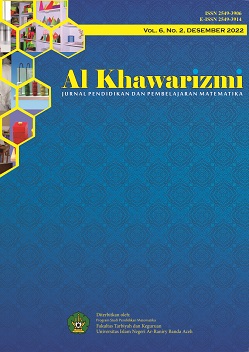Promoting Students’ Critical Thinking Skill Through Stem-Based Learning on Trigonometry
DOI:
https://doi.org/10.22373/jppm.v6i2.15482Abstract
This study aims to promote students' critical thinking skills of trigonometry by using STEM-based learning. This study was an experimental study conducted on 10th grade students of social studies MAN 1 Cirebon. The data were collected by using tests. The result showed that there was an improvement of students’ critical thinking skills after the implementation of STEM-based learning on trigonometry. Students’ posttest score of 79.83 was greater than the pretest score, which was 30.81. The paired sample t-test analysis showed that there was a significant increase from pretest to posttest score. Thus, it can be concluded that there STEM-based learning can be applied to promote students' critical thinking skills.References
Afifah, A. N., Ilmiyati, N., & Toto, T. (2019). Model project based learning (PjBL) berbasis STEM untuk meningkatkan penguasaan konsep dan keterampilan berpikir kritis siswa. Quagga: Jurnal Pendidikan Dan Biologi, 11(2), 73–78.
Arikunto, S. (2013). Prosedur Penelitian: Suatu Pendekatan Praktik. Jakarta: Rineka Cipta.
Ariyatun, A., & Octavianelis, D. F. (2020). Pengaruh Model Problem Based Learning Terintegrasi STEM terhadap Kemampuan Berpikir Kritis Siswa. Journal of Educational Chemistry (JEC), 2(1), 33-39.
Astuti, I. D., Toto, T., & Yulisma, L. (2019). Model Project Based Learning (Pjbl) Terintegrasi Stem Untuk Meningkatkan Penguasaan Konsep Dan Aktivitas Belajar Siswa. Quagga: Jurnal Pendidikan Dan Biologi, 11(2), 93.
Azizah, M., Sulianto, J., & Cintang, N. (2018). Analisis Keterampilan Berpikir Kritis Siswa Sekolah Dasar pada Pembelajaran Matematika Kurikulum 2013. Jurnal Penelitian Pendidikan, 35(1), 61–70.
Ennis, R. H. (1996). Critical thinking dispositions: Their nature and assessability. Informal Logic, 18(2).
Firdaus, F., Kailani, I., Bakar, M. N. Bin, & Bakry, B. (2015). Developing critical thinking skills of students in mathematics learning. Journal of Education and Learning, 9(3), 226–236.
Hacioğlu, Y., & Gülhan, F. (2021). The effects of STEM education on the students’ critical thinking skills and STEM perceptions. Journal of Education in Science Environment and health, 7(2), 139-155.
Hadi, S., & Novaliyosi. (2019). TIMSS Indonesia (Trends in International Mathematics and Science Study). Prosiding Seminar Nasional & Call For Papers Program Studi Magister Pendidikan Matematika Universitas Siliwangi, 562–569.
Isdianti, M., Nasrudin, H., & Erman, E. (2021). The effectiveness of STEM based inquiry learning packages to improving students’ critical thinking skill. Journal for the Education of Gifted Young Scientists, 9(3), 223-232.
Mater, N. R., Haj Hussein, M. J., Salha, S. H., Draidi, F. R., Shaqour, A. Z., Qatanani, N., & Affouneh, S. (2022). The effect of the integration of STEM on critical thinking and technology acceptance model. Educational Studies, 48(5), 642-658.
Octaviyani, I., Kusumah, Y. S., & Hasanah, A. (2020). Peningkatan kemampuan berpikir kreatif matematis siswa melalui model project-based learning dengan pendekatan stem. Journal on Mathematics Education Research, 1(1), 10-14.
OECD. (2019). Programme for international student assessment (PISA) results from PISA 2018. Oecd, 1–10.
Onsee, P., & Naungchalerm, P. 2019. Developing Critical Thinking of Grade 10 Students Through Inquiry-Based STEM Learning. Jurnal Penelitian dan Pembelajaran IPA, 5(2), 132-141.
Retnowati, S., Riyadi, R., & Subanti, S. (2020, February). The Implementation of STEM-Based Geometry Module to Improve Critical Thinking Skill. In Proceedings of the 2nd International Conference on Education, ICE 2019, 27-28 September 2019, Universitas Muhammadiyah Purworejo, Indonesia.
Roberts, A., & Cantu, D. (2012, June). Applying STEM instructional strategies to design and technology curriculum. In PATT 26 Conference; Technology Education in the 21st Century; Stockholm; Sweden; 26-30 June; 2012 (No. 073, pp. 111-118). Linköping University electronic press.
Ross, A., & Willson, V. L. (2017). Paired samples T-test. In Basic and advanced statistical tests (pp. 17-19). SensePublishers, Rotterdam.
Sa’ida, N. (2021). Implementasi Model Pembelajaran STEAM pada Pembelajaran Daring. Jurnal Review Pendidikan Dasar : Jurnal Kajian Pendidikan Dan Hasil Penelitian, 7(2), 123–128.
Saputri, A. C., & Sajidan, R. (2019). Y., Afandi, & Prasetyanti, NM (2019). Improving students’ critical thinking skills in cell-metabolism learning using Stimulating Higher Order Thinking Skills model. International Journal of Instruction, 12(1), 327-342.
Sari, N. D., & Setiawan, J. (2020). Papan gekola sebagai media pembelajaran matematika yang inovatif dengan pendekatan STEAM. Jurnal Saintika Unpam: Jurnal Sains dan Matematika Unpam, 3(1), 31-41.
Sugiyono. (2013). Metode Penelitian Kuantitatif, Kualitatif, dan R&D. Bandung: Alfabeta, CV.
Suwandi, B. D. (2008). Memahami Penelitian Kualitatif. Jakarta: PT. Rineka Cipta.
Zubaidah, S. (2019). Memberdayakan Keterampilan Abad Ke-21 melalui Pembelajaran Berbasis Proyek. Seminar Nasional Nasional Pendidikan Biologi, October, 1–19.

